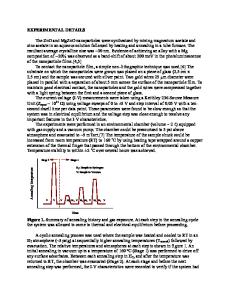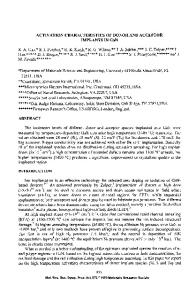Effects of annealing on donor and acceptor concentrations in Ga-doped ZnO thin films
- PDF / 77,108 Bytes
- 8 Pages / 612 x 792 pts (letter) Page_size
- 3 Downloads / 332 Views
1201-H02-06
Effects of annealing on donor and acceptor concentrations in Ga-doped ZnO thin films
David C. Look1, Kartik Ghosh2, and Kevin D. Leedy3 1
Semiconductor Research Center, Wright State University, Dayton, OH 45435, U.S.A.
2
Department of Physics, Astronomy, and Materials Science, Missouri State University,
Springfield, MO 65897, U.S.A. 3
Sensors Directorate, Air Force Research Laboratory, Wright-Patterson Air Force Base, OH
45433, U.S.A.
ABSTRACT Temperature-dependent Hall-effect measurements have been performed on three Gadoped ZnO thin films of various thicknesses (65, 177, and 283 nm), grown by pulsed laser deposition at 400 °C and annealed at 400 °C for 10 min in Ar, N2, or forming-gas (5% H2 in Ar). The donor ND and acceptor NA concentrations as a function of sample thickness and annealing conditions are determined by a new formalism that involves only ionized-impurity and boundary scattering. Before annealing, the samples are highly compensated, with ND = (2.8 ± 0.3) x 1020 cm-3 and NA = (2.6 ± 0.2) x 1020 cm-3. After annealing in Ar the samples are less compensated, with ND = 3.7 ± 0.1 x 1020 cm-3 and NA = 2.0 ± 0.1 x 1020 cm-3; furthermore, these quantities are nearly independent of thickness. However, after annealing in N2 and forming-gas, ND and NA are thickness dependent, partly due to depth-dependent diffusion of N2 and H, respectively.
INTRODUCTION
Highly conducting thin films of ZnO are being considered for many applications, including: (1) transparent electrodes for flat-panel displays and photovoltaic cells; (2) lowemissivity windows; (3) window defrosters; and (4) light-emitting and laser diodes [1-4]. At present, there is a surge of interest in developing ZnO as a replacement for indium tin oxide
(ITO), because In has become very expensive and is somewhat toxic. A key figure of merit for conductive films is the resistivity ρ; however, from a more basic point of view, ρ is determined by donor ND and acceptor NA concentrations [5], and these quantities must be determined if the material is to be developed to its fullest potential. In this work, we employ a simple, analytical method to determine ND and NA from mobility µ and carrier concentration n in degenerate semiconductor materials.
EXPERIMENTAL DETAILS
Three Ga-doped ZnO films, of thicknesses 65, 177, and 283 nm, were grown by pulsed laser deposition (PLD) using a 99.99%-pure ZnO target containing 3 wt% Ga2O3 [6]. The substrate was Si, coated with a 1-µm-thick layer of SiO2, for electrical isolation, and the substrate temperature during growth was held at 400 °C. After growth, a piece of each wafer was subjected to a 400-°C, 10-min anneal in either forming-gas (5% H2 in Ar), pure Ar, or pure N2. The forming-gas (FG) and N2 anneals were performed in a rapid thermal annealing system while the Ar anneal was carried out in a tube furnace. Temperature-dependent Hall-effect measurements were performed over the range 15 – 320 K with a LakeShore 7507 apparatus. Ohmic contacts were achieved by soldering small dots of indium onto th
Data Loading...










